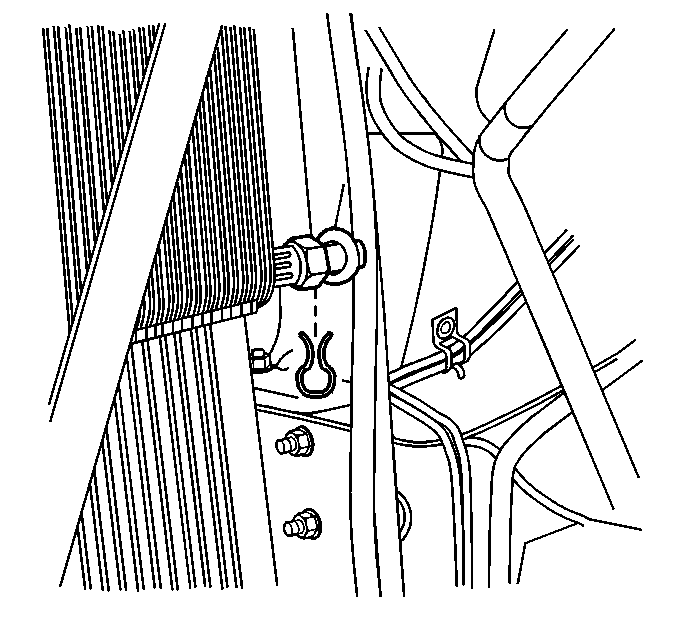Removal Procedure
Important: In order to prevent premature engine wear, flush the oil cooler and
replace the oil filter under the following conditions:
• The engine is damaged internally • The oil cooler is contaminated with foreign material
- Disconnect the negative battery cable.
- Remove the plastic cover and the engine oil cooler line nut connector clip.
- Disconnect the oil cooler line nuts at the cooler.
- Remove the cooler lines from the engine oil cooler.
- Remove the engine oil cooler mounting bolts.
- Remove the oil cooler.
Caution: Unless directed otherwise, the ignition and start switch must be in the OFF or LOCK position, and all electrical loads must be OFF before servicing any electrical component. Disconnect the negative battery cable to prevent an electrical spark should a tool or equipment come in contact with an exposed electrical terminal. Failure to follow these precautions may result in personal injury and/or damage to the vehicle or its components.


Installation Procedure
- Install the engine oil cooler to the mounting bracket.
- Install the engine oil cooler mounting bolts.
- Install the cooler line quick connector clip and protective cover. This cover must be in place to secure the connector clip.
- Connect the cooler line to the quick connector.
- Refill the engine oil to the correct level.
- Connect the negative battery cable.

Notice: Use the correct fastener in the correct location. Replacement fasteners must be the correct part number for that application. Fasteners requiring replacement or fasteners requiring the use of thread locking compound or sealant are identified in the service procedure. Do not use paints, lubricants, or corrosion inhibitors on fasteners or fastener joint surfaces unless specified. These coatings affect fastener torque and joint clamping force and may damage the fastener. Use the correct tightening sequence and specifications when installing fasteners in order to avoid damage to parts and systems.
Tighten
Tighten the engine oil cooler mounting bolts to 20 N·m
(15 lb ft).

Notice: Make sure the connector clip engages all three slots in the connector. Failure to properly install the connector clip could cause the oil cooler line to come loose and cause damage to the engine.
Use your thumb and your forefinger in order to insert the connector clip into one of the three recesses in the connector. When one end is engaged in the connector slot, use your thumb in order to rotate the clip around the connector until the clip snaps into place.
You should hear a distinct snap when you assemble the oil cooler line to the quick connector. Fully insert the oil cooler line into the quick connector. Pull the fitting forcefully in order to ensure full installation.
Caution: Unless directed otherwise, the ignition and start switch must be in the OFF or LOCK position, and all electrical loads must be OFF before servicing any electrical component. Disconnect the negative battery cable to prevent an electrical spark should a tool or equipment come in contact with an exposed electrical terminal. Failure to follow these precautions may result in personal injury and/or damage to the vehicle or its components.
